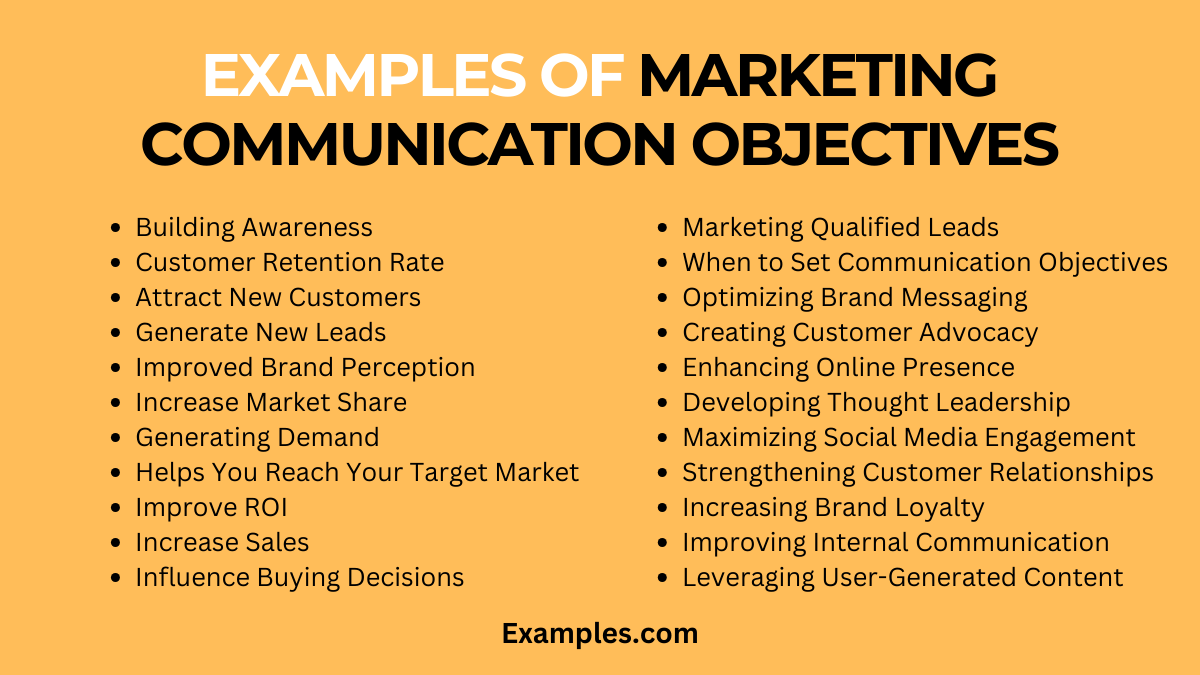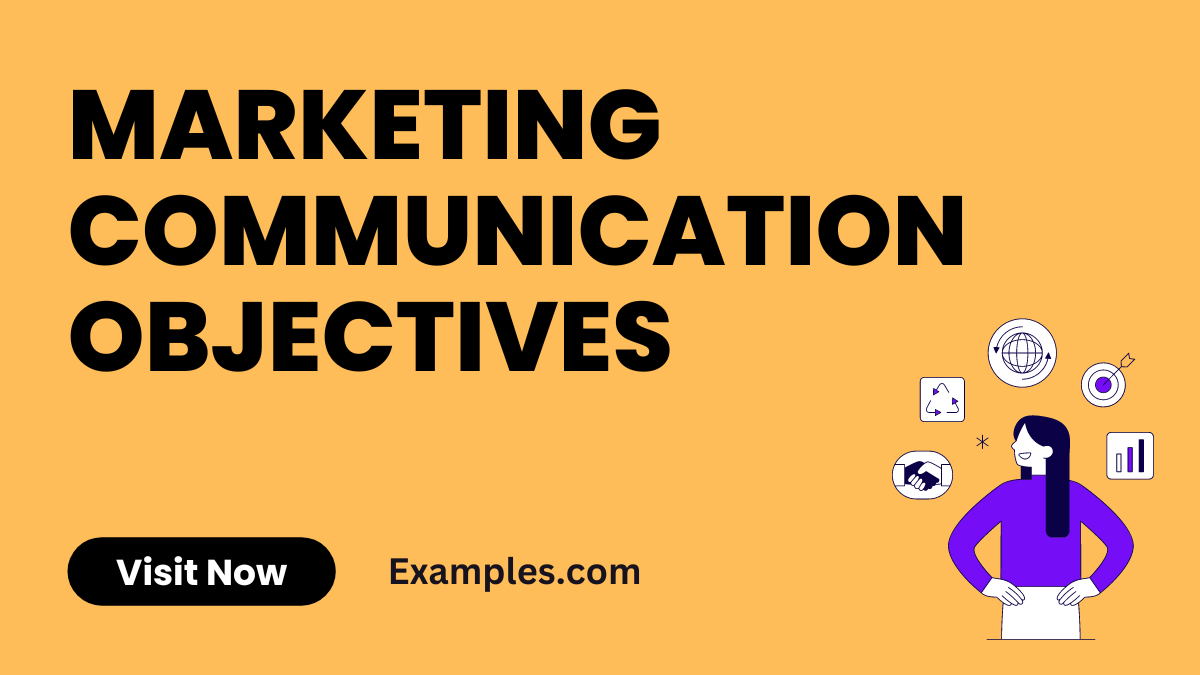25+ Marketing Communication Objectives
Delve into the world of Marketing Communication Objectives with our comprehensive guide, enriched with practical examples. This guide is designed to help you understand the pivotal role of strategic communication in building brand awareness, attracting new customers, and enhancing overall market presence. Learn how to effectively use Marketing Communication Examples to achieve objectives like customer retention, lead generation, and improved brand perception. With each objective aligned to real-world scenarios, this guide is an invaluable resource for anyone looking to elevate their marketing strategy.
25 Marketing Communication Objectives

- Building Awareness: Increase brand recognition among potential customers.
Example: Launching a multi-channel ad campaign featuring your brand’s unique selling points. - Customer Retention Rate: Improve the rate at which existing customers remain engaged with the brand.
Example: Implementing a loyalty program that rewards repeat purchases. - Attract New Customers: Expand your customer base by targeting new market segments.
Example: Using targeted social media ads to reach a younger demographic. - Generate New Leads: Create interest among potential customers to convert them into leads.
Example: Offering a free ebook download in exchange for email sign-ups. - Improved Brand Perception: Enhance public perception of your brand.
Example: Running a public relations campaign that highlights your brand’s community involvement. - Increase Market Share: Gain a larger portion of the market in your industry.
Example: Introducing competitive pricing strategies to attract customers from competitors. - Generating Demand: Create a need for your product or service in the market.
Example: Showcasing the unique benefits of your product through influencer partnerships. - Helps You Reach Your Target Market: Precisely target the demographics most likely to purchase.
Example: Utilizing data analytics to tailor your marketing messages to specific audience segments. - Improve ROI: Achieve a higher return on investment for marketing efforts.
Example: Focusing on high-performing channels and discontinuing underperforming campaigns. - Increase Sales: Boost the number of sales transactions.
Example: Launching a limited-time promotion to create urgency. - Influence Buying Decisions: Shape how consumers perceive and choose your products.
Example: Creating compelling content that addresses customer pain points. - Marketing Qualified Leads: Generate leads that are more likely to become customers.
Example: Using lead scoring models to prioritize follow-up with high-potential leads. - When to Set Communication Objectives: Identify the right time to set and revise objectives.
Example: Re-evaluating objectives post-product launch to align with customer feedback. - Optimizing Brand Messaging: Refine your brand’s message for clarity and impact.
Example: Redesigning your website and marketing materials to reflect a more modern brand image. - Creating Customer Advocacy: Turn customers into brand advocates.
Example: Encouraging satisfied customers to share their experiences online. - Enhancing Online Presence: Strengthen your brand’s online visibility.
Example: Investing in SEO and content marketing to improve your website’s search engine ranking. - Developing Thought Leadership: Establish your brand as a thought leader in your industry.
Example: Publishing insightful articles and whitepapers on industry trends. - Maximizing Social Media Engagement: Increase engagement on social media platforms.
Example: Running interactive social media campaigns with quizzes and polls. - Strengthening Customer Relationships: Build stronger connections with your customer base.
Example: Sending personalized email newsletters to customers based on their interests. - Increasing Brand Loyalty: Cultivate a loyal customer base.
Example: Offering exclusive benefits to repeat customers. - Improving Internal Communication: Enhance communication within the company.
Example: Implementing an internal communications platform for better employee alignment with brand goals. - Leveraging User-Generated Content: Use content created by customers for marketing.
Example: Featuring customer photos and reviews in your marketing campaigns. - Streamlining the Marketing Process: Make your marketing efforts more efficient.
Example: Automating repetitive tasks like email marketing and social media posts. - Enhancing Cross-Channel Coordination: Ensure consistency across different marketing channels.
Example: Synchronizing messaging across social media, email, and print advertising. - Measuring Marketing Effectiveness: Regularly assess the success of your marketing strategies.
Example: Using analytics tools to track campaign performance and adjust strategies accordingly.
What are Communication Objectives in Marketing?
Communication objectives in marketing are specific goals that an organization aims to achieve through its marketing communication strategies. These objectives guide the creation and execution of marketing messages. Here are ten key communication objectives:
- Brand Awareness: Increasing the visibility and recognition of the brand among the target audience.
Example: A startup launching a social media campaign to introduce its brand to potential customers. - Product Knowledge: Educating the audience about the product’s features and benefits.
Example: A tech company using explainer videos to demonstrate the use of its latest gadget. - Brand Preference: Positioning the brand as a preferred choice over competitors.
Example: A beverage company highlighting its unique selling proposition in ad campaigns. - Lead Generation: Generating interest and inquiries from potential customers.
Example: An online retailer offering a free ebook in exchange for email sign-ups. - Sales Conversion: Encouraging the audience to make a purchase.
Example: An e-commerce platform sending personalized discount offers to its subscribers. - Customer Retention: Keeping existing customers engaged and loyal to the brand.
Example: A loyalty program that rewards customers for repeat purchases. - Reputation Management: Building and maintaining a positive brand image.
Example: A company actively managing its online reviews and responding to customer feedback. - Market Expansion: Expanding the brand’s reach into new markets or demographics.
Example: A fashion brand launching a new line targeted at a younger audience. - Customer Education: Informing customers about how to best use the product or service.
Example: A software company offering free webinars to educate users about its product. - Engagement and Interaction: Encouraging active participation and interaction from the audience. Example: A beauty brand hosting a social media contest to engage its followers.
How to write Marketing Communication Objectives?
Writing effective marketing communication objectives involves a clear understanding of the brand’s goals and the target audience. Here are ten points to consider:
- Be Specific: Clearly define what you want to achieve.
Example: Increase website traffic by 30% in the next quarter. - Make it Measurable: Set objectives that can be quantified.
Example: Gain 500 new email subscribers within two months. - Ensure Relevance: Align objectives with the overall business goals.
Example: Boost online sales to contribute to the annual revenue target. - Set Time Frames: Include a specific timeframe for achieving the objectives.
Example: Launch the new product campaign by the end of the first quarter. - Consider the Target Audience: Tailor objectives to the needs and preferences of your target audience.
Example: Enhance engagement among the 18-25 age group on social media platforms. - Incorporate Brand Values: Reflect the brand’s core values in your objectives.
Example: Communicate the brand’s commitment to sustainability in all advertising. - Focus on Differentiation: Highlight what sets your brand apart.
Example: Showcase unique product features that competitors do not offer. - Plan for Flexibility: Be prepared to adjust objectives as market conditions change.
Example: Adapt the campaign to new consumer trends observed in the industry. - Integrate Multiple Channels: Utilize a mix of channels for a comprehensive approach.
Example: Combine social media, email, and in-store promotions for a holistic campaign. - Encourage Customer Action: Aim for objectives that prompt customer action.
Example: Drive in-store visits through an online coupon campaign.
Marketing communication Goals and Objectives
- Increase Market Share: Aim to capture a larger portion of the market.
Example: Target new customer segments to expand market reach. - Enhance Customer Value: Focus on adding value to the customer’s experience.
Example: Offer exclusive content or benefits to loyal customers. - Build Brand Equity: Strengthen the value associated with the brand.
Example: Create a consistent brand experience across all touchpoints. - Improve Customer Relations: Develop stronger relationships with customers.
Example: Implement a customer feedback system to enhance interaction. - Strengthen Corporate Image: Enhance the perception of the company in the eyes of stakeholders.
Example: Engage in corporate social responsibility initiatives. - Facilitate Product Launches: Successfully introduce new products to the market.
Example: Use teaser campaigns to build anticipation for new product releases. - Drive Event Attendance: Increase attendance at company events or webinars.
Example: Use targeted invites and reminders to boost event participation. - Promote Special Offers: Effectively communicate time-limited offers or discounts.
Example: Create urgency in campaigns for seasonal sales. - Support Sales Strategies: Align communication efforts with sales objectives.
Example: Develop promotional materials that assist the sales team. - Crisis Communication: Manage communication effectively during a crisis to maintain brand integrity.
Example: Quick and transparent communication in response to any negative incidents.
What is a Marketing Communication Objective in Advertising?
In advertising, a marketing communication objective is a specific goal that an advertising campaign aims to achieve. These objectives guide the development and execution of advertising strategies. Here are ten common objectives:
- Creating Brand Recall: Ensuring that consumers remember the brand when making purchasing decisions.
Example: Memorable taglines in ads that stick with the audience. - Informing Potential Customers: Providing information about products or services to potential buyers.
Example: Infomercials that explain the benefits of a product in detail. - Persuading Consumers: Convincing consumers to choose your product over competitors.
Example: Comparative advertising showing the advantages of your product. - Emotional Connection: Establishing an emotional bond with the audience.
Example: Ads that tell a story and evoke emotions related to the brand. - Changing Customer Attitudes: Influencing consumer perceptions and attitudes towards the brand.
Example: Ads that address misconceptions or present the brand in a new light. - Supporting Sales Efforts: Creating advertisements that directly support sales initiatives.
Example: Limited-time offers in ads to drive immediate purchases. - Enhancing Brand Loyalty: Focusing on keeping existing customers engaged and loyal.
Example: Ads that reinforce the benefits of staying loyal to the brand. - Targeting Specific Segments: Reaching out to particular segments of the market.
Example: Ads tailored to appeal to a niche audience. - Driving Online Engagement: Encouraging interaction and engagement on digital platforms.
Example: Social media ads with calls to action for likes, shares, or comments. - Launching New Products: Creating awareness and interest in a new product.
Example: Launch campaigns that showcase the innovation and benefits of the new product.
Each of these objectives plays a crucial role in the success of advertising campaigns, contributing to the overall marketing communication strategy of a brand.
In conclusion, setting clear and effective marketing communication objectives is vital for any successful marketing strategy. By understanding the importance of these objectives, employing strategic steps in writing them, and incorporating them into various marketing goals, businesses can create impactful messages that resonate with their audience, driving engagement, and achieving desired outcomes. This guide provides essential insights and practical tips for crafting compelling marketing communication objectives.



